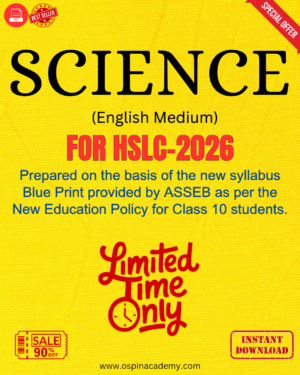SEBA Class 10 Science Chapter 11 – The Human Eye and the Colourful World Solutions & Summary
Looking for detailed solutions to Class 10 Science Chapter 11 – “The Human Eye and the Colourful World”? Ospin Academy provides accurate NCERT solutions and notes for SEBA students.
📖 Chapter Overview:
This chapter explains the structure and function of the human eye, common vision defects and their corrections, and the science behind natural optical phenomena such as dispersion, scattering, and atmospheric refraction.
📌 Key Topics Covered:
- Structure and Function of the Human Eye
- Common Eye Defects (Myopia, Hypermetropia, Presbyopia) and Their Corrections
- Dispersion of Light and Formation of the Spectrum
- Atmospheric Refraction and Optical Effects (Twinkling of Stars, Mirage)
- Scattering of Light and Its Applications (Tyndall Effect, Sky’s Color)
📌 Important Questions for Exams:
- Explain the working of the human eye with a neat diagram.
- Describe the correction of myopia and hypermetropia.
- What causes the dispersion of white light through a prism?
- Why do stars appear to twinkle?
- Explain the Tyndall effect and its everyday applications.
📝 How Ospin Academy Helps:
- Accurate NCERT Solutions for SEBA Syllabus
- Clear Diagrams for Better Understanding
- Concise Revision Notes for Board Exams
- Step-by-Step Solutions to Practice Questions
Get the best solutions for SEBA Class 10 Science Chapter 11 – “The Human Eye and the Colourful World” exclusively on Ospin Academy!
Class 10 Science (English Medium) PDF Solutions 2025-26 | SEBA Assam
Download Class 10 Science (English Medium) PDF with detailed solutions, MCQs, and extra practice questions for SEBA Assam 2025-26.
SEBA Class 10 Science Chapter 11 – The Human Eye and the Colourful World FAQs
Get Free NCERT PDFs
If you want to download free PDFs of any chapter, click the link below and join our WhatsApp group:


